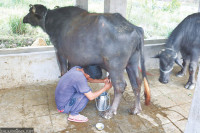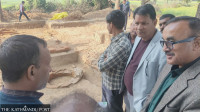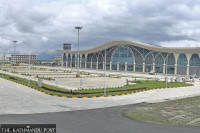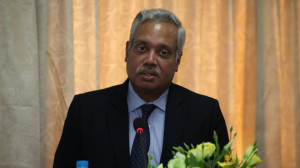National
Geologists investigate sinkhole that swallowed vehicle in Hetauda
Experts explore possible causes of road collapse, as local residents express concerns about further subsidence.
Pratap Bista
A team of four geologists arrived in Hetauda on Tuesday to begin a field study of the area where a vehicle disappeared into the ground following a road collapse five days ago.
The incident occurred in Gairigaun, ward 16 of Hetauda Sub-metropolitan City, where the road caved in on Friday, creating a swamp-like sinkhole. The vehicle, which was transporting fish, remains missing.
The study was initiated at the sub-metropolitan city’s request. The team is led by geologist Narayan Adhikari and includes Krishna Pandey, Mani Khanal, and Amar Bahadur Thapa, a lab technician from the Department of Mines and Geology. The experts spoke with the driver, Hareram Rai, to gather details of the incident. They also consulted long-time residents such as Bhairav Rai for preliminary information about the area’s geology.
Due to safety concerns, authorities have barred all movement within 100 metres of the sinkhole. “This area once had a lake, and the subsoil contains black clay,” said one geologist. “The ground may have collapsed due to seismic activity or borewell drilling, but we will know more after the study.”
Hetauda Mayor Mina Kumari Lama, Deputy Mayor Rajesh Baniya, and ward representatives from various areas were present during the site inspection.
Eyewitnesses said the vehicle had been parked when the road suddenly caved in, and it vanished within seconds. While the driver and helper escaped in time, the vehicle has not been recovered. Despite attempts to drain water from the area, the vehicle has yet to be located.
The disaster prompted a meeting of the Municipal Disaster Management Committee on Sunday, with the participation of Chief District Officer Scheme Shrestha. The committee decided to postpone recovery efforts until geologists could assess the site.
Residents living near the collapse zone, including the owner of a nearby concrete house, have expressed anxiety about further subsidence. The collapse site is also close to a fishpond and borewell, and geologists suspect that excessive groundwater extraction may have contributed to the collapse.




 6.12°C Kathmandu
6.12°C Kathmandu















